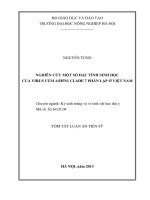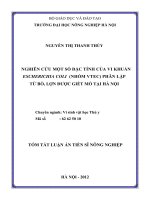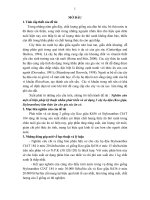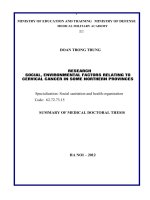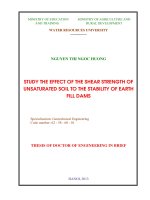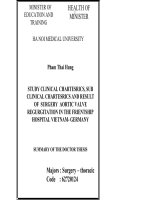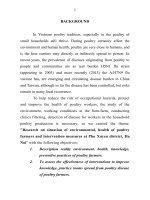tóm tắt luận án tiếng anh: Nghiên cứu một số đáp ứng sinh lý, hóa sinh liên quan đến phản ứng tự bảo vệ của cây đậu tương Nam Đàn (Glycine max (L.) Merr.) đối với rệp muội đen (Aphis craccivora Koch).
Bạn đang xem bản rút gọn của tài liệu. Xem và tải ngay bản đầy đủ của tài liệu tại đây (420.29 KB, 29 trang )
MINISTRY OF EDUCATION AND TRAINING
HANOI NATIONAL UNIVERSITY OF EDUCATON
TRAN NGOC TOAN
STUDY ON PHYSIOLOGICAL AND BIOCHEMICAL
RESPONSES RELATE TO DEFENSE RESPONSE
OF SOYBEAN (Glycine max (L.) Merr. cv. “Nam Dan”)
TO COWPEA APHID (Aphis craccivora Koch)
Speciality: Plant Physiology
No: 9420112
SUMMARY OF DOCTORAL THESIS
HA NOI - 2023
THIS STUDY HAS BEEN DONE AT
HANOI NATIONAL UNIVERSITY OF EDUCATION
Supervisors: 1. Associate professor Tran Thi Thanh Huyen
2. Associate professor Mai Van Chung
Review 1: Associate professor Nguyen Van Dinh, Hanoi Pedagogical University 2
Review 2: Associate professor Cao Phi Bang, Hungvuong University
Review 3: Associate professor Bui Minh Hong, Hanoi National University of
Education
This thesis will be defensed in front of Thesis Judging Committee at Hanoi
National University of Education at ……………, 2023
This thesis can be found at: National Library, Hanoi
Or Hanoi National University of Education’s Library
LIST OF PUBLICATIONS
1.
Tran Ngoc Toan, Tran Thi Thanh Huyen, Mai Van Chung (2016), “Antioxidative
defense responses to aphid-induced oxidative stress in Glycine max (L.) Merr.cv.
“Nam Dan”, Vietnam Journal of Science and Technology, 54(6), tr. 719-728, DOI:
10.15625/0866-708X/54/6/7952, (ISSN 0866-708x).
2.
Ngoc Toan Tran, Thi Thanh Huyen Tran, Ngoc Dai Do, Van Chung Mai (2017),
“The accumulation of SA- and JA-signaling pathways in the response of Glycine
max cv. “Nam Dan” to infestation by Aphis craccivora” Journal of Plant
Protection Reseacrh, 57 (4), tr. 321–330, DOI: 10.1515/jppr-2017-0043, (ISSN:
1427-4345).
3.
Tran Ngoc Toan, Ngo Thi Lien, Nguyen Thi Hoang Anh, Tran Thi Thanh
Huyen and Mai Van Chung (2019), “Effect of Cowpea Aphid on the
biosynthetic pathway of Salicylic acid in Glycine max cv. Namdan at
reproductive growth stages”, Journal of Science Vinh University , 48 (2A). tr.
29-38, (ISSN: 1859 – 2228).
1
INTRODUCTION
1. Regarding Rationale of the study
Plant species is affected by many different biotic and abiotic stress from
environment in its life cycle. Although always suffer a certain amount of damage,
most of plant still survive and develop well. This is because plants develop different
self-defense mechanisms that are compatible with each effector. In the ability to
actively protect plants, biochemical defense mechanisms have been attracting the
attention of many scientists. According to this mechanism, fungi, bacteria, viruses,
insects are groups pathogens known to produce elicitors that induce the formation of
metabolic products of different origins: hormones, enzymes, genes, proteins,
secondary exchange products, free radicals...; initiate special protective responses
such as hypersensitive response (HR); stimulates systemic acquired resistance (SAR).
At the same time, different signal transduction pathways, for example: biosynthesis
of plant hormones salicylic acid (SA), jasmonic acid (JA), ethylene (ET); The
activated oxygen signaling pathway… is also activated. All form defense
mechanisms specific to each type of plant for each impact factor.
In the interaction between legumes (Fabaceae) and insect, there have been
studies around the world evaluating the machinery and protective mechanisms of
soybean Glycine max (Diaz-Montano et al. 2007; Li). et al. 2008), clover Medicago
truncatula (Klingler et al. 2007; Gao et al. 2008), lentils Lens culinaris (Andarge and
Westhuizen 2004), alfalfa Medicago sativa (Julier 2004), peas Pisum sativum L. (Mai
et al. 2014; Morkunas et al. 2015). These studies reported that, when under the
influence of aphids, some plant hormones (SA, JA, ET, etc.), active ingredients such
as pisatin, flavonoids..., activated forms of oxygen/nitrogen Endogenous substances
such as H2O2, NO, as well as superoxide anion radical (superoxide O 2., semiquinone),
biosynthetic enzymes as well as genes encoding the aforementioned enzymes have
different synthesis inducers to participate in protective reactions. of plants against
aphids (Morunas et al. 2011).
Nam Dan soybean is a local variety associated with the brand "Nam Dan soy
sauce" of Nghe An province, which was successfully restored in 2009 and started to
be produced widely. On this soybean, cowpea aphid (Aphis craccivora Koch) often
arises, causing damage from the end of stem and leaf development, beginning to form
flower buds and lasting throughout the fruiting period, and seed filling. The assessment
2
of the self-defense mechanism of plants against aphids will provide an important
database on the physiology of plant tolerance to adverse agents.
Currently, there is no research has been done for this issue on Nam Dan soybean.
Due to that, the implementation of " Study on physiological and biochemical responses
relate to defense response of soybean (Glycine max (L.) Merr. cv. “Nam Dan”) to
cowpea aphid (Aphis craccivora Koch)” is needed.
2. Objectives of the study
Analysis and evaluation of a number of physiological and biochemical
responses related to the self-defense response of Nam Dan soybean when black
aphid attacked at the vegetative growth stages V1, V3 and V5.
- Specific goals:
Evaluation of some damage at the cellular level in soybean leaves caused
by aphids through indicators, and lipid peroxidation;
Analysis and evaluation of biosynthesis and pathway of signal molecules such
as JA, SA, H2O2 and superoxide radical O2.- in Nam Dan soybean leaves during
vegetative growth under the influence of cowpea aphids;
Evaluation of the activity of some enzymes involved in the synthesis of the
above signaling molecules. These are the LOX enzymes in JA synthesis; PAL and
BA2H participate in SA synthesis; SOD and CAT are endogenous H2O2
metabolism enzymes in Nam Dan soybean leaves during vegetative growth under
the influence of cowpea aphid.
3. Scientific and practical significance of the study
Studying protective responses of plants to insect attack is a new direction
which have not done yet in Vietnam so far. The current study is the first study on
physiological and biochemical responses related to the self-protective response of
Nam Dan soybean in Vietnam.
The research results aim to provide scientific data on the self-protection
mechanism of Nam Dan soybean plant against cowpea aphid, contributing to clarify
the theoretical basis of the physiological resistance of the plant to the disease, adverse
environmental factors, including biotic factors.
The project findings were the premise for further studies on the relationship
between soybean plants and aphids, thereby finding solutions to prevent aphids on
Nam Dan soybean variety.
4. Contribution of the study
3
This is the first work on defense ability of Nam Dan soybean plant against
cowpea aphid. The findings in this study will be the first scientific data on the selfprotection mechanism of Nam Dan soybean plant against cowpea aphid, including:
- Effect of cowpea aphids on Nam Dan soybean leaf cells (Rate of damage in
cells; Lipid peroxidation of membrance);
- Content of signal molecules pathway in Nam Dan soybean leaves under the
influence of cowpea aphid (H2O2, O2.-, SA, JA);
- Induction of activity of some enzymes that synthesize/metabolize signal
molecules in Nam Dan soybean leaves under the influence of cowpea aphid (SOD,
CAT, PAL, BA2H, LOX).
The results obtained in this study will be important, scientifically meaningful,
and valuable references to plant physiology, especially plant tolerance physiology.
Moreover, the study will also provide an important database for plant protection,
suggestions for research, and application of solutions to enhance the resistance of
Nam Dan soybean.
5. Thesis structure
Preface
Chapter 1. Introduction
Chapter 2. Material and Methodology
Chapter 3. Result and Discussion
Conclusion and Suggestion
Publications
References
Supplements
CHAPTER 1. INTRODUCTION
There are many works dealing with defense mechanisms at the molecular level,
related to the activation of plant signaling pathways, the reception of molecular
signals, the exchange relationship between plants and animals. crossover of these
molecules in the defense signaling network. Signals mediating various defensive
responses are of interest to plant scientists not only because of their biological nature
but also because of their important role in agriculture.
4
In Vietnam, studies on the interaction between aphids and plants mainly focus
on composition, biological characteristics, pest density and aphid control measures on
different crops. Some studies have focused on substances with aphrodisiac activity
from insect parasitic fungi. Regarding the self-protection mechanism of plants, there
are studies under the influence of heavy metals. Thereby, it suggests that, in Vietnam,
there have not been in-depth studies on the self-protection mechanism of plants
against the attack of aphids, including soybean.
CHAPTER 2. MATERIAL AND METHODOLOGY
2.1. Material
2.1.1. Nam Đan soybean
The plant used in this study is Nam Dan soybean variety (Glycine max (L.)
Merr.), provided by the Agricultural Extension Station of Nam Dan district (Nghe An
province).
Sterilized seeds were incubated for germination, then planted in the laboratory.
Soybean plants at the stages V1, V3 and V5 (corresponding to the vegetative growth
stages, with 1, 3 and 5 compound leaves) were used as research materials.
2.1.2. Cowpea aphid
The aphids used in the experiments were cowpea aphid (Aphis craccivora
Koch) cultured by the Department of Applied Entomology (Institute of Ecology and
Biological Resources, Vietnam Academy of Science and Technology). Virus-free
individuals were reared on their host soybean plant, in a grow-chamber at 23 – 250C,
relative humidity 70–75 %, light intensity 110–130 μM photons. mM photons. m2, and the time
period 14 hours light/10 hours dark.
2.2. Area of study
Study on some physiological and biochemical responses related to selfprotection response of Nam Dan soybean (Glycine max (L.) Merr.) at the vegetative
growth stage (V1, V3 and V5) to with cowpea aphids (Aphis craccivora Koch) was
carried out from 2015 to 2019. The experiments were arranged in the Laboratory of
Plant Physiology and Laboratory of Plant Science, Vinh University.
The concentrations of plant hormones SA and JA were analyzed in cooperation
with the Institute of Natural Compound Chemistry (Vietnam Academy of Science and
5
Technology). The expression of the gene encoding PAL was analyzed in collaboration
with the Institute of Biotechnology (Vietnam Academy of Science and Technology).
Other indicators were analyzed at the Plant Physiology Laboratory and the
Plant Science Laboratory, Vinh University.
2.3. Contents of study
* Effect of cowpea aphids on Nam Dan soybean leaf cells
- Rate of damage in cells
- Lipid peroxidation of membrance
* Content of signal molecules pathway in Nam Dan soybean leaves under the
influence of cowpea aphid:
- Active oxygen
+ Superoxide free radicals
+ Hydrogen peroxide
- Salicylic acid
- Jasmonic acid
* Induction of activity of some enzymes that synthesize/metabolize signal molecules
in Nam Dan soybean leaves under the influence of cowpea aphid:
- Enzymes that convert active oxygen species
+ Enzyme Superoxide Dismutase
+ Enzyme Catalase
- Salicylic acid biosynthetic enzyme
+ Enzyme Phenylalanine ammonia-lyase
+ Enzyme Benzoic 2-hydroxylase
- Jasmonic acid biosynthetic enzyme
+ Enzyme Lipoxygenase
2.4. Methodology
2.4.1. Experiment design
Soybean plants at the vegetative growth stages V1, V3 and V5 were used to set
up the experiments.
At each growth stage, the experiment was arranged in a completely
randomized block design (RCBD) with 4 treatments, and 3 replications:
Treatment 1 (control): no infestation
Treatment 2: infecting 10 aphids/plant
Treatment 3: infecting 20 aphids/plant
6
Treatment 4: infecting 30 aphids/plant
Selected aphids (adults, wingless) were carefully transferred to the leaves of the
experimental soybean plants with a fine-bristled brush. Pupation or dead individuals
were removed every day and supplemented with new individuals to limit the effect of
density on aphid performance so that the number of black aphids remained constant
in each experiment. Soybean plants in the aphid-infested and control treatments were
placed separately in net cages (50 × 50 × 50 cm) and placed in a growing chamber at
23 – 25 oC, 70-75% humidity, 110-130 µM photons.m-2.s-1 light intensity and lighting
time is 14 hours light /10 hours dark.
At the growth stages V1, V3 and V5, on the experimental treatments, soybean
leaves were collected at 0 h, 24 h, 48 h, 72 h and 96 h, respectively, after aphid
infestation. Leaves were taken and equilibrated with electronic analytical balance,
then frozen with liquid nitrogen and kept at-70 °C for further analyses. Particularly,
the content of superoxide anion radicals (O2.-) and hydrogen peroxide (H2O2) were
determined in fresh raw materials according to the specific contents of the study.
2.4.2. Analysis methods
Injury percentage of the plasma membrane
Electrolyte leakage was conductometrically measured to assess the injury
percentage of the plasma membrane (Sullivan et al., 1971).
Lipid peroxidation
The level of lipid peroxidation was determined by thiobarbituric acid
reactive substances
(TBARS) assay (Heath R. L. và Packer L, 1968).
Determination of superoxide anion radical content
The determination of superoxide anion radical (O2.-) content in biological
samples was based on its ability to reduce nitro blue tetrazolium (NBT) (Doke N.,
1983).
Determination of hydrogen peroxide content
The content of hydrogen peroxide (H2O2) was determined following the
spectrophotometric
method (Becana M. và cs. 1986).
Determination of enzyme superoxide dismutase, the enzyme catalase
The activity of SOD (EC 1.15.1.1) was spectrophotometrically assayed by
measuring its
7
ability to inhibit the photochemical reduction of NBT (Beauchamp C. và cs.
1971).
Salicylic acid measurement
Free salicylic acid (SA) was extracted and quantified following the highperformance liquid chromatography (HPLC) method described by Yalpani et al.
(1993)
Phenylalanin amoniac-lyase measurement
Phenylalanine ammonia-lyase (PAL, EC 4.3.1.24) activity was determined
using the spectrophotometric method (Cahill và McComb, 1992).
Benzoic acid 2-hydroxylase measurement
Benzoic acid 2-hydroxylase (BA2H) was measured by using the HPLC method
according to León et al. (1995)
Jasmonates measurement
Jasmonic acid (JA) and its metyl este (MeJA) was measured following method
described by GC-MS (Fan et al., 1998)
Enzyme lipoxygenase measurement
Activity of lipoxygenase (LOX, EC 1.13.11.12) was determined using the
spectrophotometric method (Sekhar and Reddy, 1982).
Determination of protein
In all the enzyme preparations, the protein in soybean seedlings’ leaves was
determined following the method of Bradford (1976) using bovine serum albumin
(Sigma-Aldrich) as a standard.
2.4.3. Statistical analysis
Analysis of variance (ANOVA) was applied to verify whether means from the
given experimental variants were significantly different with the level of significance
as P-value < 0.05 on SPSS 20.0. software
CHAPTER 3.
RESULT AND DISCUSSION
3.1. Effect of cowpea aphids on Nam Dan soybean leaf cells
3.1.1. The percentage of injury in soybean “Nam Dan” leaves’ cells
8
Table 3.1. Injury in Nam Dan soybean leaf cells when affected by cowpea aphid
TG
CT
0h
V1 growth stage
0,00a A
10 aphids
0,00a A
20 aphids
0,00a A
30 aphids
V3 growth stage
0,00a A
10 aphids
0,00a A
20 aphids
0,00a A
30 aphids
V5 growth stage
0,00a A
10 aphids
0,00a A
20 aphids
0,00a A
30 aphids
Injury (%)
24h
48h
72h
96h
2,63 ± 0,27a B
2,67 ± 0,31a B
3,49 ± 0,47b B
3,98 ± 0,44a C
7,35 ± 0,28b D
8,99 ± 0,63c D
3,52 ± 0,29a C
5,99 ± 0,57b C
9,23 ± 0,48c D
3,46 ± 0,27a C
5,83 ± 0,46b C
7,25 ± 0,55c C
2,54 ± 0,46a B
2,20 ± 0,48a B
3,45 ± 0,40b B
3,87 ± 0,33a D
6,24 ± 0,32b D
8,79 ± 0,54c C
3,43 ± 0,39a CD
5,96 ± 0,43b D
8,42 ± 0,28c C
3,01 ± 0,49a C
3,02 ± 0,28a C
3,76 ± 0,56a B
3,32 ± 0,36a C
5,96 ± 0,27b D
5,13 ± 0,69b C
3,34 ± 0,31a C
5,25 ± 0,40b C
5,76 ± 0,39b C
3,21 ± 0,27a C
5,03 ± 0,40b C
5,98 ± 0,34c C
2,68 ± 0,24a B
2,98 ± 0,19ab B
3,56 ± 0,53b B
(Note: Considering each growth stage separately, in the same column
there are different exponential letters (lowercase letters) with p<0.05;
in the same row there are different exponential letters (uppercase)
difference (p<0.05 according to Duncan's test).
The results obtained in Table 3.1 showed that the effects of black soya aphid
caused damage to Nam Dan soybean leaf cells. The lesion rate increased from 0 h to
24 h and continued to remain high for 48 - 72 h, then this rate decreased to a low
level at 96 h at all different aphid densities for all 3 growth stages V1, V3, V5. This
result is completely consistent with the research results recorded on pea plants
(Pisum sativum L.) when damaged by aphids (Acyrthosiphon pisum Harris).
Accordingly, electrolyte leakage in all 10-day-old seedling leaves infected by
different numbers of aphids increased from 0 to 72 h, and then decreased to 96 h. Cell
damage in all treatments with aphids was highest at 72 h (3.19%, 4.58% and 7.51%
respectively for 10, 20 and 30 aphids) higher than the control plants (Van Chung Mai
et al., 2014).
The effect of Pb2+ also resulted in damage to DT84 soybean root cells, this rate
increased after 24 hours and peaked at 48 hours, the highest was 25.03% in the
1.0mM Pb2+ formula, up to 96 hours. the index decreased to 9.59 - 12.14% (Mai Van
Chung, Tran Ngoc Toan, 2015). The results obtained in our experiments showed that
there were some similarities in the increase in cell damage at the time points after
Pb2+ treatment or aphid treatment (increased after 24 h of treatment, followed by
treatment continued to increase or maintain, and then fell to a low at 96 hours).
9
However, the recorded damage rate was completely different, according to which
DT84 soybean root cells were damaged at a very high level (the highest was 25.03%
at 48 hours), while Nam Dan soybean leaf cells had a damage level of 2.71 times
smaller (the highest was 9.23% at 72 hours in phase V1).
3.1.2. Lipid peroxidation
Table 3.2. The thiobarbituric acid content in Nam Dan soybean leaves when
affected by aphid
TG
The thiobarbituric acid content (µM TBARS/g FW)
CT
0h
V1 growth stage
Control
3,62 ± 0,15a A
10 aphids
3,62 ± 0,15a A
20 aphids
3,62 ± 0,15a A
30 aphids
3,62 ± 0,15a A
V3 growth stage
Control
3,45 ± 0,37a A
10 aphids
3,45 ± 0,37a A
20 aphids
3,45 ± 0,37a A
30 aphids
3,45 ± 0,37a A
V5 growth stage
Control
1,92 ± 0,31a A
10 aphids
1,92 ± 0,31a A
20 aphids
1,92 ± 0,31a A
30 aphids
1,92 ± 0,31a A
24h
48h
72h
96h
4,35 ± 0,43a A
6,02 ± 0,24b B
6,08 ± 0,23b B
6,25 ± 0,43b B
4,38 ± 0,20a A 4,42 ± 0,54a A
7,56 ± 0,30b C 8,39 ± 0,14b D
9,31 ± 0,20c C 11,64 ± 0,21d D
12,97 ± 0,42d D 10,45 ± 0,40c C
4,38 ± 0,42a A
7,88 ± 0,17b C
9,57 ± 0,51c C
9,92 ± 0,32c C
4,01 ± 0,33a A
5,88 ± 0,39c B
5,25 ± 0,13b B
7,92 ± 0,38d B
4,02 ± 0,18a A
7,34 ± 0,29b C
9,18 ± 0,55c C
12,44 ± 0,31d D
4,03 ± 0,37a A
8,11 ± 0,36b D
11,31 ± 0,34c D
11,34 ± 0,36c C
5,02 ± 0,52a B
8,24 ± 0,32b D
9,03 ± 0,25c C
11,58 ± 0,40d C
2,24 ± 0,19a AB
2,91 ± 0,17b B
2,97 ± 0,15b B
3,43 ± 0,45b B
2,26 ± 0,17a AB
2,94 ± 0,18b B
3,05 ± 0,37b B
3,38 ± 0,21b B
2,44 ± 0,20a B
3,64 ± 0,09b C
5,04 ± 0,26c C
5,67 ± 0,36d D
2,65 ± 0,20a B
3,31 ± 0,20b C
3,15 ± 0,26b B
4,97 ± 0,34c C
(Note: Considering each growth stage separately, in the same column there are
different exponential letters (lowercase letters) with p<0.05; in the same row there
are different exponential letters (uppercase) difference (p<0.05 according to
Duncan's test).
When the aphids were affected, the TBARS content in Nam Dan soybean leaves
in the treatments with aphids in the growth stages V1, V3, V5 all increased and were
higher than the control and the baseline time. For the low density (10 individuals),
TBARS content increased and reached a high level, then maintained or decreased at
72 – 96 hours. While the treatments were infested at higher densities (20 individuals
and 30 individuals), TBARS concentrations increased and peaked between 48 and 72
hours, but they all decreased at 96 hours.
The results of our study on Nam Dan soybean are in agreement with previous
reports, all of which confirmed that the increase in lipid peroxidation in crops (such
as beans) is directly caused by attack of bed bugs (Capinera J. L, 2001). Thus, with
the invasion of black aphid, oxidation caused destruction of membrane integrity by
10
increasing cell membrane damage and activating lipid peroxidation in Nam Dan
soybean. The percentage of cell damage tended to increase 24 hours after the aphid
attack and reached a high level between 48 and 72 hours, however, they tended to
decrease at 96 hours after the aphid attack.
The effect of aphid on Nam Dan soybean leaf cells stimulated strong production
of ROS (O2.- và H2O2) in Nam Dan soybean leaf cells and induced this oxidation. This
process will be clarified in the next section.
3.2. Content of signal molecules pathway in Nam Dan soybean leaves under the
influence of cowpea aphid
3.2.1. Reactive oxygen
3.2.1.1. Superoxide anion radical
Table 3.3. Superoxide anion radical content in Nam Dan soybean leaves
when affected by aphid
TG
Superoxide anion radical content (A580/g FW)
0h
CT
V1 growth stage
2,43 ± 0,36a A
Control
10 aphids 2,43 ± 0,36a A
20 aphids 2,43 ± 0,36a A
2,43 ± 0,36a A
30 aphids
V3 growth stage
2,22 ± 0,32a A
Control
10 aphids 2,22 ± 0,32a A
20 aphids 2,22 ± 0,32a A
30 aphids 2,22 ± 0,32a A
V5 growth stage
Control
10 aphids
20 aphids
30 aphids
1,95 ± 0,25a A
24h
48h
72h
96h
2,49 ± 0,14a A
5,75 ± 0,28b D
7,39 ± 0,26c D
7,75 ± 0,41c D
2,58 ± 0,13a A
4,72 ± 0,09b C
5,19 ± 0,22c C
6,70 ± 0,24d C
2,44 ± 0,10a A
3,55 ± 0,27b B
4,97 ± 0,22c C
3,15 ± 0,29b B
2,40 ± 0,23a A
2,38 ± 0,23a A
3,24 ± 0,18c B
2,83 ± 0,19b AB
2,37 ± 0,30a A
5,64 ± 0,33b B
7,03 ± 0,37c D
8,73 ± 0,32d D
2,01 ± 0,46a A
5,84 ± 0,46bc B
5,12 ± 0,38b C
6,49 ± 0,23c C
2,08 ± 0,43a A 2,50 ± 0,34ab A
2,45 ± 0,30ab A 2,02 ± 0,31a A
3,03 ± 0,30b B 2,78 ± 0,22b AB
2,98 ± 0,27b B 2,64 ± 0,22b AB
2,01 ± 0,32a
2,14 ± 0,25a A 1,98 ± 0,23a A
2,26 ± 0,10a A
4,78 ± 0,23b D 4,27 ± 0,13b C
2,49 ± 0,24ab B
1,95 ± 0,25a A 5,57 ± 0,23c E 4,99 ± 0,25b D 4,08 ± 0,24b C
1,95 ± 0,25a A 6,37 ± 0,25d E 5,53 ± 0,31c D 4,38 ± 0,18b C
2,78 ± 0,22bc B
3,15 ± 0,27c B
1,95 ± 0,25
aA
A
4,98 ± 0,23b
D
(Note: Considering each growth stage separately, in the same column there are
different exponential letters (lowercase letters) with p<0.05; in the same row there
are different exponential letters (uppercase) difference (p<0.05 according to
Duncan's test).
The results obtained from our study showed that all 3 growth stages V1, V3,
V5 when attacked by aphids led to changes in the content of free radicals O2.- in the
leaves of Nam Dan soybean tends to increase rapidly in the early stage (in which, O2-
11
concentration reaches the highest level after 24 hours since the aphid damage) and
then decreases in about 48-72 hours and reaches the lowest level at the time of pest
infestation. 96 hours after bedbug infestation. From these results, it is shown that O2radicals are generated when plants are stressed not only by drought, salinity, high
temperature, cold, heavy metals, ozone, lack of oxygen, aluminum... but also by
aphids attack.
3.2.1.2. Hydrogen peroxide in Nam Dan soybean leaves when aphid affects
Table 3.4. Hydrogen peroxide content in Nam Dan soybean leaves when
affected by aphid
TG
0h
CT
V1 growth stage
Control
5,12 ± 0,49a AB
10 aphids
5,12 ± 0,49a A
20 aphids
5,12 ± 0,49a A
30 aphids
5,12 ± 0,49a A
V3 growth stage
Control
6,13 ± 0,36a A
10 aphids
6,13 ± 0,36a A
20 aphids
6,13 ± 0,36a A
30 aphids
6,13 ± 0,36a A
V5 growth stage
Control
5,53 ± 0,40a BC
10 aphids
5,53 ± 0,40a A
20 aphids
5,53 ± 0,40a A
30 aphids
5,53 ± 0,40a A
Hydrogen peroxide content(µM/g FW)
24h
48h
72h
5,60 ± 0,34a B
10,62 ± 0,37b C
14,16 ± 0,44d D
13,24 ± 0,41c E
4,47 ± 0,36a A
11,50 ± 0,49c D
10,75 ± 0,44bc C
10,17 ± 0,35b D
5,31 ± 0,42a B
6,90 ± 0,60b B
7,34 ± 0,45b B
7,61 ± 0,40b C
96h
5,02 ± 0,40a AB
5,35 ± 0,40a A
5,76 ± 0,43a A
6,57 ± 0,36b B
6,58 ± 0,64a AB 7,49 ± 0,49a B
6,15 ± 0,40a A 7,02 ± 0,45a AB
7,47 ± 0,35a B 11,56 ± 0,46b C 11,08 ± 0,42c C 7,48 ± 0,48a B
15,58 ± 0,47b E 14,47 ± 0,24d D 12,03 ± 0,46d C 10,04 ± 0,56b B
17,92 ± 0,48c D 13,52 ± 0,29c C 9,53 ± 0,45b B 10,05 ± 0,73b B
4,54 ± 0,56a A
11,68 ± 0,40b C
12,76 ± 0,39c E
11,93 ± 0,48bc D
4,92 ± 0,45a AB
12,65 ± 0,36c D
11,83 ± 0,47b D
11,18 ± 0,37b D
5,90 ± 0,44a C
7,67 ± 0,29b B
9,51 ± 0,40c C
9,91 ± 0,50c C
5,52 ± 0,28a BC
5,53 ± 0,40a A
6,34 ± 0,43b B
7,22 ± 0,34c B
(Note: Considering each growth stage separately, in the same column there are
different exponential letters (lowercase letters) with p<0.05; in the same row there
are different exponential letters (uppercase) difference (p<0.05 according to
Duncan's test).
The increase in H2O2 associated with cell death in aphid-infested areas is
known as the oxidative stress in the plant defense mechanism (Radville et al., 2011)
and may be the central component in mechanism of cross tolerance in plants (Maffei
et al., 2007). H2O2 also functions as a deterrent to insect feeding (Apel and Hirt
2004). The production of H2O2 has been known as a phytoprotective response in
many plant-aphid interactions (Argandona et al. 2001; Moran et al., 2002; ZhuSalzman et al., 2004; Divol and colleagues). et al., 2005; Moloi and van der
Westhuizen, 2006; Boyko et al., 2006; Kusnierczyk et al., 2008).
12
H2O2 is a relatively stable, partially reduced form of ROS, and its ability to
freely diffuse allows H2O2 to play a controlling role in plant defense responses
(Bo´ka et al., 2007). H2O2 induces the intracellular release of Ca2+, which is a very
important, ubiquitous signaling molecule involved in many signaling pathways
in plants (Tuteja and Mahajan, 2007).
H2O2 also activates several members of the mitogen-activated protein kinase
(MAPK) family, which are central to the regulation of plant cell responses to stress,
for example, AtMPK3 and AtMPK6 in Arabidopsis ( Desikan et al., 2005). As a
signaling molecule in plant defense mechanisms, H2O2 accumulation may be the start
of a chain of events that trigger physiological and molecular responses to reduce
aphid attacks (Argandona et al. et al., 2001).
In a recent study by Mai et al. 2013, a significant enhancement of H2O2 was
observed to activate the defense mechanism of legume (Pisum sativum cv. Cysterski)
against attack by aphid (Acyrthosiphon pisum). Similar to the above results, the
increase of H2O2 content in Nam Dan soybean leaves at growth stages V1, V3, V5
infected with aphids within 0-24 hours after aphid invasion was evaluated as closely
related to the defensive aspects of the plants.
In contrast, high levels of H2O2 involved in oxidation can have toxic effects,
and uncontrolled generation often causes damage to cellular components such as
proteins, lipids, and proteins. nucleic acids (Ahmad et al., 2008). The results of our
study showed that the invasion of aphid stimulated the strong production of O2.- and
H2O2 in the cells of Nam Dan soybean leaves, causing oxidation that destroys the
integrity of the leaves. membrane due to an increase in the percentage of membrane
damage and activation of lipid peroxidation.
13
3.2.2. Salicylic acid in Nam Dan soybean leaves when aphid affected
Table 3.5. Salicylic acid content in Nam Dan soybean leaves when the aphis affects
TG
0h
CT
V1 growth stage
Control
34,28 ± 0,39a B
10 aphids 34,28 ± 0,39a A
20 aphids 34,28 ± 0,39a A
30 aphids 34,28 ± 0,39a A
V3 growth stage
Control
32,76 ± 0,45a A
10 aphids 32,76 ± 0,45a A
20 aphids 32,76 ± 0,45a A
30 aphids 32,76 ± 0,45a A
V5 growth stage
Control
30,70 ± 0,48a A
10 aphids 30,70 ± 0,48a A
20 aphids 30,70 ± 0,48a A
30 aphids 30,70 ± 0,48a A
Salicylic acid content (ng/g FW)
24h
48h
72h
96h
30,46 ± 0,37a A
78,34 ± 0,53b D
106,42 ± 0,99c D
111,40 ± 0,65d E
35,76 ± 0,44a C
77,58 ± 0,38b D
90,64 ± 0,46c C
97,38 ± 0,41d D
36,24 ± 0,46a C
58,13 ± 0,47d C
50,59 ± 0,41b B
54,63 ± 0,68c C
30,57 ± 0,46a A
54,08 ± 0,43d B
49,59 ± 0,47c B
48,64 ± 0,50b B
48,08 ± 0,53a C
79,32 ± 0,57b D
133,07 ± 0,48c D
151,38 ± 0,46d E
52,65 ± 0,59a E
90,03 ± 0,42b E
137,96 ± 0,76c E
141,24 ± 0,51d D
46,24 ± 0,47a B
62,47 ± 0,43b C
68,13 ± 0,42c C
112,21 ± 0,67d C
49,63 ± 0,50a D
60,39 ± 0,38b B
63,04 ± 0,50c B
63,09 ± 0,57c B
38,48 ± 0,42a B
49,10 ± 0,57b B
79,25 ± 0,41c E
86,15 ± 0,43d D
41,25 ± 0,27a C
68,05 ± 0,55b E
72,48 ± 0,41c D
91,19 ± 0,55d E
41,09 ± 0,31a C
60,45 ± 0,47c D
54,26 ± 0,28b C
60,76 ± 0,76c C
43,04 ± 0,38a D
56,64 ± 0,52c C
50,41 ± 0,47b B
58,80 ± 0,48d B
(Note: Considering each growth stage separately, in the same column there are
different exponential letters (lowercase letters) with p<0.05; in the same row there
are different exponential letters (uppercase) difference (p<0.05 according to
Duncan's test).
Plant-aphid interaction studies have shown that endogenous SA is strongly
produced at higher levels in aphid resistant cultivars and that SA content
increases after aphid exposure (Mohase et al. van der Westhuizen, 2002). Our
present study agrees with these reports because the results obtained show that
the effects of black aphid caused a significant increase in SA content in leaves of
Nam Dan soybean in all regions. The growth stage V1, V3, V5 from the time of
infection with aphids and peaks in about 24-48 hours.
14
3.2.3. Jasmonic acid in Nam Dan soybean leaves when affected by aphids
Table 3.6. The content of jasmonic acid in Nam Dan soybean leaves
when aphid affects
TG
CT
0h
V1 growth stage
163,52 ± 9,64a
AB
Control
163,52 ± 9,64a
A
10 aphids
163,52 ± 9,64a
A
20 aphids
163,52 ± 9,64a
A
30 aphids
V3 growth stage
160,25 ± 8,72a
A
Control
160,25 ± 8,72a
A
10 aphids
160,25 ± 8,72a
A
20 aphids
160,25 ± 8,72a
A
30 aphids
V5 growth stage
134,22 ± 9,67a
B
Control
134,22 ± 9,67a
A
10 aphids
134,22 ± 9,67a
A
20 aphids
134,22 ± 9,67a
A
30 aphids
Jasmonic acid content (ng/g FW)
24h
48h
72h
162,02 ± 7,01a
AB
96h
193,28 ± 9,49a C 151,57 ± 7,55a A 172,29 ± 8,90a B
198,88 ± 18,02b 266,81 ± 12,06b 298,93 ± 13,87b 322,27 ± 14,64b
B
C
D
D
235,99 ± 11,41c 315,44 ± 13,48c 396,72 ± 19,53c 373,19 ± 13,66c
B
C
D
D
221,43 ± 12,12ab 303,07 ± 12,32c 438,38 ± 14,38d 354,35 ± 14,65c
B
C
E
165,36 ± 11,76a
A
D
169,07 ± 14,01a
298,19 ± 20,04d
157,04 ± 7,76a A A
150,05 ± 8,78a A
210,67 ± 11,06b 270,18 ± 12,22b 305,56 ± 12,04b
D
B
C
D
278,61 ± 10,39c 400,08 ± 13,17c 340,22 ± 13,22c
D
C
268,36 ± 9,70c B B
234,73 ± 13,65b 311,25 ± 12,70d 493,68 ± 12,57d 474,85 ± 15,47d
B
C
D
D
132,98 ± 7,32a B 113,80 ± 7,54a A 141,09 ± 9,79a B 135,82 ± 7,63a B
211,88 ± 11,35b
165,31 ± 8,20b B 214,66 ± 9,56b C 223,40 ± 8,69b C C
230,62 ± 12,61d 239,46 ± 11,08c 304,58 ± 12,63c 233,64 ± 12,87b
B
B
305,03 ± 13,42
210,41 ± 9,12c B
D
C
d
B
282,41 ± 14,76c
325,87 ± 8,56d E
C
(Note: Considering each growth stage separately, in the same column there are
different exponential letters (lowercase letters) with p<0.05; in the same row there
are different exponential letters (uppercase) difference (p<0.05 according to
Duncan's test).
Jasmonic acid performs its protective functions by regulating the expression of
both direct and indirect defenses against insects (War et al., 2011). During direct
defense, through the basic helix-to-helix transcription factor MYC2, JA enhances
flavonoid biosynthesis, leading to the synthesis of defense compounds such as indole
glucosinolates, which act as toxins. deter animals with general herbivory activity
15
(Fujita et al., 2009). The expression of MYC2 was significantly higher in plants
attacked by aphids at high densities (Kroes et al., 2015). JA also affects calciumdependent protein kinase (CDPK) transcription, which plays an important role in
plant defense against various stressors through signal transduction (Ulloa et al.,
2002). In soybean, almost all wound-modulating GmCDPK-induced defense
responses in herbivores and herbivores are independent of JA signaling
(Hettenhausen et al. 2016). In addition, JA plays a role in indirect defense against
insect pests through the induction of oxidizing enzymes, proteinase inhibitors,
alkaloids and volatile compounds (War et al. 2011).
Because of their potential roles in the synthesis of protective compounds or in
resistance to oxidative stress, JA and compounds involved in plant resistance against
herbivores. JA is also known to send important signals in the wound response of plants.
During feeding, aphids penetrate plant tissues and lead to cellular damage such as cell wall
disturbance or plasma membrane disruption (Tjallingii, 2006). JA and its derivatives
directly promote the formation of COI1-JAZ complexes - specific components of
'signaling markers' that evoke a specific response to wound (Katsir et al., 2008).
Research results on legume (Pisum sativum L. cv. Cysterski) showed an
increase in JA content after being affected by aphids (Acyrthosiphon pisum) (Van
Chung Mai et al., 2014). Our results showed that there was also a significant increase
in JA content after 24 h and peaked between 72 h - 96 h after bedbug infestation.
3.3. Induction of activity of some enzymes that synthesize/metabolize signal
molecules in Nam Dan soybean leaves under the influence of aphid
3.3.1. Activity of antioxidant enzymes
3.3.1.1. Enzyme Superoxide dismutase under the influence of aphid
Table 3.7. Superoxide dismutase enzyme activity in Nam Dan soybean leaves
when affected by aphid
Enzyme superoxide dismutase activity (nkat/mg protein)
TG
CT
0h
24h
48h
72h
96h
V1 growth stage
10,62 ± 0,40a 12,34 ± 0,29a
11,61 ± 0,43a
10,95 ± 0,44a
aC
12,10
±
0,38
A
C
BC
AB
Control
10,62 ± 0,40a 13,56 ± 0,38b 18,03 ± 0,39b
23,54 ± 0,42b D 23,87 ± 0,30c D
A
B
C
10 aphids
10,62 ± 0,40a 13,78 ± 0,49b
20,36 ± 0,47c C 25,04 ± 0,39c D 19,67 ± 0,32b C
A
B
20 aphids
10,62 ± 0,40a 14,26 ± 0,36b 25,48 ± 0,40d
24,85 ± 0,44c D 20,22 ± 0,37b C
A
B
D
30 aphids
V3 growth stage
16
Control
11,80 ± 0,40a
14,94 ± 0,41a
A
B
11,80 ± 0,40
10 aphids
20 aphids
a
A
B
11,80 ± 0,40a
16,06 ± 0,34b
A
B
11,80 ± 0,40a
18,04 ± 0,43c
A
B
30 aphids
V5 growth stage
Control
10 aphids
20 aphids
30 aphids
16,03 ± 0,49
b
13,4 ± 0,41a A
13,4 ± 0,41a A
13,4 ± 0,41a A
13,4 ± 0,41a A
16,95 ± 0,42a
15,98 ± 0,40a C 15,03 ± 0,39a B
23,72 ± 0,40b
C
28,43 ± 0,46c D
27,65 ± 0,30c
D
30,83 ± 0,40d E
14,52 ± 0,43a B
31,49 ± 0,39d E 27,42 ± 0,39b D
23,06 ± 0,26b C
B
17,96 ± 0,42a C
19,36 ± 0,34b
28,01 ± 0,38b
B
C
22,64 ± 0,32c
B
22,15 ± 0,38c
B
17,61 ± 0,30a
31,20 ± 0,39d E
25,15 ± 0,43c C
BC
17,22 ± 0,35a B
32,13 ± 0,40b E
31,08 ± 0,51c D
30,32 ± 0,39c C 35,21 ± 0,40d D
30,12 ± 0,39b C
36,03 ± 0,56d E 33,14 ± 0,32c D
30,26 ± 0,40b C
(Note: Considering each growth stage separately, in the same column there are
different exponential letters (lowercase letters) with p<0.05; in the same row there
are different exponential letters (uppercase) difference (p<0.05 according to
Duncan's test).
In living cells, SOD forms the first line of defense against ROS, as this enzyme
can counteract oxidative damage caused by excessive accumulation of superoxide
anion radicals. When the enzyme involved in O2-reduction, SOD activity increased
significantly in aphid-infested leaves of Nam Dan soybean, causing a sharp decrease
in O2- level over a period of 48 - 72 hours in Nam Dan soybean leaves affected by
aphids contributed to a significant reduction in the content of O2- (O2- content
reached the highest at 24 hours but then decreased sharply from 48 - 96 hours). When
this radical was maintained at a low level after 72 h, the activity of SOD also tended
to decrease.
3.3.1.2. Enzyme Catalase in Nam Dan soybean leaves affected by aphids
Table 3.8. Catalase enzyme activity in Nam Dan soybean leave when aphid affects
TG
CT
0h
V1 growth stage
Control
6,57 ± 0,31a A
10 aphids 6,57 ± 0,31a A
20 aphids 6,57 ± 0,31a A
30 aphids 6,57 ± 0,31a A
V3 growth stage
Control
8,02 ± 0,32a A
10 aphids
8,02 ± 0,32a A
20 aphids
8,02 ± 0,32a A
Catalase enzyme activity (nkat/mg protein)
24h
48h
72h
96h
7,02 ± 0,54a AB 7,88 ± 0,40a C
11,30 ± 0,39b C 12,34 ± 0,32b D
12,83 ± 0,38c B 14,28 ± 0,27c C
14,43 ± 0,44d C 15,13 ± 0,41d D
7,23 ± 0,32a ABC
11,54 ± 0,42b C
15,65 ± 0,43d D
13,07 ± 0,35c B
7,69 ± 0,32a BC
10,26 ± 0,19b B
14,62 ± 0,27d C
13,04 ± 0,30c B
10,01 ± 0,27a C 10,06 ± 0,50a C
12,52 ± 0,72b B 17,50 ± 0,15b D
19,04 ± 0,48c B 22,46 ± 0,34d D
8,84 ± 0,40a B
17,59 ± 0,29b D
22,48 ± 0,36c D
9,63 ± 0,26a C
15,01 ± 0,33b C
21,30 ± 0,33d C
17
30 aphids
8,02 ± 0,32a A
V5 growth stage
Control
7,43 ± 0,42a A
10 aphids
7,43 ± 0,42a A
20 aphids
7,43 ± 0,42a A
30 aphids
7,43 ± 0,42a A
22,97 ± 0,40d E 20,03 ± 0,42c D
16,98 ± 0,46b B
17,92 ± 0,39c C
7,45 ± 0,32a A 8,52 ± 0,33a B
8,94 ± 0,39a B
9,07 ± 0,23a B
bC
bD
b BC
13,90 ± 0,36
14,75 ± 0,28
14,19 ± 0,26
12,62 ± 0,38b B
18,61 ± 0,40c B 22,49 ± 0,43c C 18,04 ± 0,54c B 17,98 ± 0,40d B
20,92 ± 0,34d D 21,94 ± 0,41c E 18,96 ± 0,37d C 16,03 ± 0,54c B
(Note: Considering each growth stage separately, in the same column there are
different exponential letters (lowercase letters) with p<0.05; in the same row there are
different exponential letters (uppercase) difference (p<0.05 according to Duncan's
test).
Our study showed that CAT can contribute to the defense mechanism of Nam
Dan soybean plant against cowpea aphid invasion by regulating H2O2 concentration
(disproportionately higher activation of CAT compared with the production of H 2O2
in soybean leaves). The high activity of CAT within 24-96 hours strongly catalyzes
the breakdown of H2O2 to H2O and O2, thereby reducing the level of this ROS
product, and the relatively low accumulation of H2O2 between 48 and 96 hours has
probably due to the high activation of CAT (described in section 3.2.1.2 and section
3.3.1.2). The strong enhancement of CAT protects soybean leaf cells against an
excess of H2O2 and thus against significant membrane damage.
The high efficiency of antioxidant enzymes such as SOD and CAT observed in
Nam Dan soybean is one of the most important factors of the defense mechanism against
oxidative stress. SOD and CAT are formulated to regulate O2.- and H 2O2, they act as a
defense factor helping to detoxify excess ROS to reduce oxidative damage. In addition,
the enhanced activity of SOD and CAT in soybean leaves under black soya aphid attack
also played an important role in stress tolerance of Nam Dan soybean.
3.3.2. Salicylic acid biosynthetic enzyme
3.3.2.1. Phenylalanine ammonia-lyase enzyme and expression of Phenylalanine
ammonia-lyase gene (PAL)
Table 3.9. Enzyme activity of phenylalanine ammonia-lyase in Nam Dan soybean
leaves when affected aphid
TG
CT
Enzyme phenylalanine ammonia-lyase activity
(µmol cinnamic acid/mg protein/h)
24h
48h
72h
0h
V1 growth stage
8,78 ± 0,24a
Control
B
7,78 ± 0,40a A
8,78 ± 0,24a
10,48 ± 0,53b
14,63 ± 0,46b
A
B
D
10 aphids
10,02 ± 0,50a
D
9,63 ± 0,36a CD
16,37 ± 0,48c E
96h
8,99 ± 0,44a BC
13,51 ± 0,23b
C
